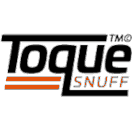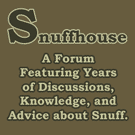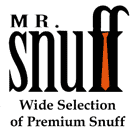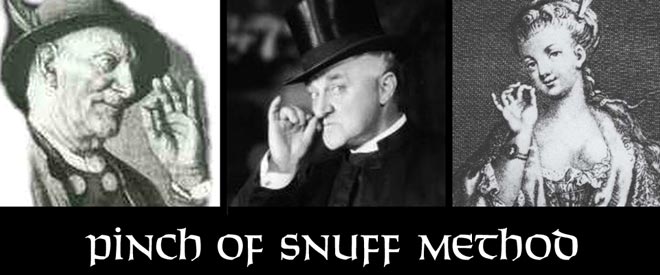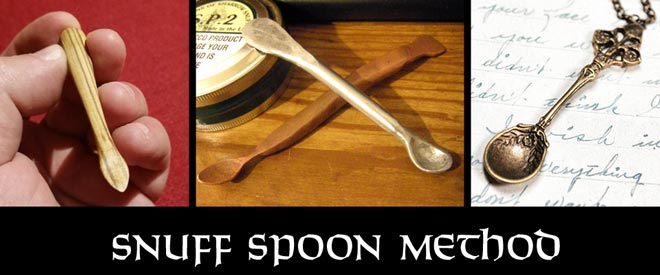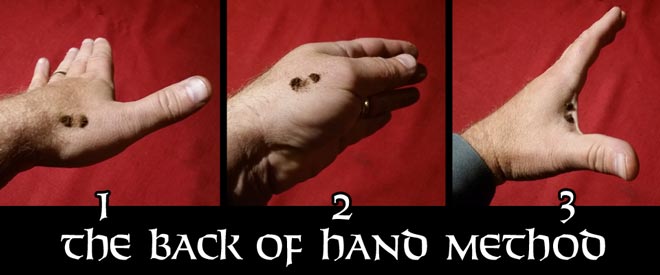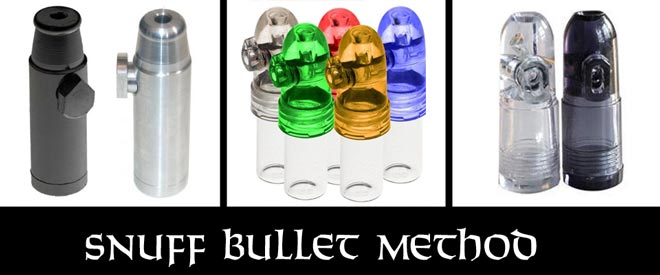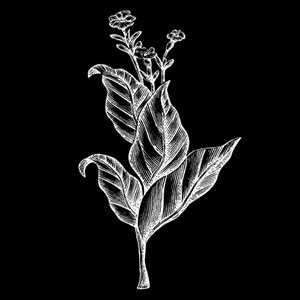|
PAGES |
Snuffing Techniques Here's the bottom-line. Someway or another, the snuff tobacco has to make its way into your nose. There are many methods for doing this, and no one method is the correct one. Every snuff-taker has their favorite way or ways, and often a snuff-taker will use different techniques with different kinds of snuff. Below you'll find the most common ways of snuff-taking described in detail. But, first we'll cover some basic tips, and then move on to the actual snuff-taking techniques. You can read down through the page in order, or use these bookmarks to read in any order you'd prefer.
Tips for
Enjoyable Snuff-Taking
Other Adjustments You Can Make
|
One major adjustment is the distance the snuff is from your nostril when you sniff. If you are pinching, then you can vary how quickly you release the tobacco you are pinching as you sniff. Leaving the other nostril open while you sniff can help the snuff not enter your nose so deeply. And of course, you can reduce or increase the amount of snuff you are taking at one time to adjust the impact as well.
Another little adjustment that has worked well for me involves considering how you prepare a pile of snuff for sniffing. For instance, when placing a little pile on the back of your hand, you can flatten that pile out to about the size of a watermelon seed rather than leaving it as a little cone shaped pile. Something about the flattened pile of snuff makes it go in different directions when it enters your nose, and this helps it not go so deep.
The bottom line here, is that if you are having trouble taking a particular snuff, make adjustments in your technique until you figure out what works best for you while taking that snuff.
Snuff-taking does change what's going on in your nose. Depending on the kind of snuff you are taking, the frequency with with you are taking it, and even depending on the humidity around you, snuff will do different things in your nose. Some of the finer snuffs just seem to go away. But other snuffs can cause your nose to drip or feel "full" or obstructed. In those cases, simply blow your nose. There is no tried and true rule about how often to blow your nose. But, if you feel like you need to blow your nose, you probably should.
Blowing your nose can have another purpose as well. If the inside of your nose is lined with a fine layer of snuff, subsequent snuff-taking may give you less enjoyment, because the new snuff is falling on old snuff and not up against the tissues inside your nose. In this situation, blowing your nose "clears the stage," in a sense. Some people carry colored hankerchiefs in their pocket for this purpose. Napkins and kleenex work just as well, but perhaps with a little less flair than a snuff hankerchief.
Usually the steam from a hot shower once a day will help clean out your nose and keep things moving up there. Some snuff-takers will spray saline solution or use a Neti pot once in a while to clean their sinuses. Others will wet a q-tip and clean the inside of their nose that way. You'll hear different approaches to this but, for the most part, my nose takes care of itself. A hot shower is all I need to feel like my nose is starting from scratch. If you nose gets irritated, feels bad, or has a chronic burning...its time to take a break. Listen to your nose!
As odd as it sounds, some snuff types, brands, or flavors just aren't going to work for you. They might work well for others, but everyone's nose is different. Perhaps menthol opens your nose up, but then shuts it up for three days afterward. Maybe dry snuffs irritate your nose, and cause you hours of discomfort. It could be that you just can't adjust to certain grinds of snuff. It doesn't matter if every other snuff-taker you know loves a certain snuff, it is very possible that a certain snuff just doesn't get along with your nose. So, be aware of this and don't get frustrated about it. It is what it is.
All that being said, sometimes you will not react well to a snuff the first time to you try it, but when you come back to it later everything goes well. So, when a snuff causes you problems, set it aside and consider coming back to it later to see if things have changed.
Snuff-Taking Techniques
This is a simple and traditional way to take snuff. In its simplest form, you take a small pinch of snuff between your thumb and forefinger and hold the pinch beneath one of your nostrils. You then lightly sniff as you release the pinch. By varying the strength of your sniff and the speed with which you release the pinch from your fingers you have a lot of control over the speed with which the snuff enters your nose and how deep it travels. With practice, this is a very effective technique.
By taking a larger pinch, you can release about half of it into one nostril, and then the second half into the second nostril, drawing snuff tobacco into both nostrils with just one pinch. Regardless of whether it takes one pinch or two, taking a pinch of tobacco warms it with your body heat and brings out more of of the tobacco's aroma and flavor.

The pinch can be brought to your nose at a variety of angles, and you can vary the twist of your wrist to adjust this angle. In Images 1 through 3 above, the three snuff takers are bringing the pinch to their nose a little differently differently. What probably matters most is the position of the thumb. With fine snuffs or toasts, your focus is more on very slowly releasing your pinch as you sniff. In this case, you might end up positioning the thumb and finger side-by-side, without either being closest to the floor (see Image 1 above). As you sniff, you roll the pinch slowly between your finger and thumb, slowly releasing the contents of the pinch into your nose.
With courser or heavier snuff, you can position the pinch so that the thumbnail is pointed downwards (see Images 2 and 3 above) with the thumb closest to the floor. The thumb then provides an excellent platform or floor for the pinch as you take your sniff. In this configuration, the thumb can be brought very close to the nostril (but never in it!) helping control or vary the strenght of your sniffing action. This is especially helpful with getting course heavier snuffs into your nose, and with keeping them from falling out once they are in there.Looking at many classic images/drawings of people taking snuff, the thumb is often seen positioned closest to the floor with the other fingers extended out gracefully (see the images below). There is a grace and formality to this form of taking a pinch, similar perhaps to sticking your pinky finger out as you cradle a cup of tea. When snuff was at its peak popularity in Europe , there were strong cultural norms and specific ways a "cultured" person would take snuff. In a sense, the whole act became a social ritual. In the modern world, there are less cultural norms or rules surrounding it. So, do what works best for your own enjoyment.
A pinch can be used to move snuff from your snuff box onto the back of your hand or into your boxcar (see that method's description below). This is usually a little easier with the use of a spoon or a tap box. If you are already pinching the tobacco, you might as well take the snuff into your nose directly from the pinch that is already between your thumb and forefinger. Occassionally, snuff-takers will move snuff from their snuff box into their boxcar in order to warm the snuff between their finger and thumb.
There is a slightly more complex method of taking a pinch, that involves pinching enough snuff for both nostrils between your thumb and middle-finger. You then raise the pinch to your right nostril with your palm upturned and pointed toward your face. You can then lay your ring-finger along the left side of your nose, closing your left nostril while you sniff half of the snuff into your right nostril. You then move the pinch beneath your left nostril, and lay your fore-finger along the right side of your nose. In this way, you close off your right nostril while sniffing into your left nostril. With a little practice, this can be done very quickly and effectively. This method would assist with a medium to course grind, because it closes the non-sniffing nostril during the snuff-taking. Click Here to see a video of this complicated method being demonstrated.
A very small spoon is a very handy tool to any snuff-taker. It can be used to move snuff from a storage container into your daily snuff-box without contaminating the snuff in the storage container with your fingers. This can be especially important in maintaining the freshness of artisan snuffs. A spoon can also be used to take snuff from your snuff-box and place it on the back of your hand or into your boxcar (see below). A snuff spoon is especially helpful with dark or oiled snuffs, because it keeps your fingers clean.
But, you can also take the snuff into your nose directly from the small snuff spoon. Simply use the spoon to pick up enough snuff for one nostril, raise it to just below one of your nostrils, and sniff. Then repeat this process for the other nostril. There are even rare double-spoons that allow you to take snuff up both nostrils at once directly from the spoon.
This is actually one of my favorite ways to take snuff. There is less control than when taking a pinch, because you are not controlling the snuff from between your thumb and finger as you sniff from a spoon. But, as with the other techniques, with a little practice you learn you how far away from your nose to hold the spoon and the angle that works for you. Taking your snuff from a spoon can be a very quick and pleasent way to enjoy snuff.
Taking your snuff from a spoon can also become necessary if your hands are dirty from manual labor or you are sweating. No one wants to pinching snuff with dirty fingers or take their snuff off the back of a sweaty hand.
There are many kinds of snuff spoons, including silver, pewter, wood, and even very fancy ones with gems or jewels. But, many snuff-takers use non-spoon objects in a spoon-like fashion. I've heard of snuff-takers using coffee stir sticks, the blade of a pocket knife, a broken off pencil, the tip of the handle of a large eating spoon, the tip of a key, or about anything else they have handy that can be used to pick up a small quantity of snuff and bring it to your nose.
This method uses a portion of the back of your hand as a surface from which to sniff the tobacco into your nose. There are various portions of the back of your hand that you can use, and really it comes down to what works for you. You can put one small pile on the back of your hand, sniff it into one nostril, and then repeat this with a second pile sniffed into the other nostril. If you are taking snuff in this way one nostril at a time, you can use a finger from your other hand to shut the other nostril. I rarely do this, but many people do. My personal preference is to put two small piles on the back of my hand about nose-width apart, and sniff into both nostrils at once. In my opinion, this is much quicker and easier than doing it one nostril at a time.
You should experiment with this yourself, but I usually start with my nostrils just a little bit away from the piles of snuff and, as I sniff, I move my nose onto the surface of my hand while taking the tobacco into my nose. A small lateral movement back and forth of your hand just as you finish off the sniff tends to clean up all the tobacco, from both your hand and your nose.
The first of the locations you can use on the back of your hand, is what is referred to as the "anatomical snuffbox" (see Image 1 above). This area is a depression that forms behind your thumb when you stretch your thumb out away from your hand. It can vary in depth, and thus usefulness in snuff-taking, from person to person. Another factor that can stand in the usefulness of this location, is hair. If you have hairy arms, the anatomical snuffbox may feature body hair which can get in the way of a good snuff-taking. But, so common was the use of this area of the hand for snuff-taking, that it became a part of anitomical terminology.
My personal preference, is the flat surface of the side of the hand between the thumb and the wrist (see Image 2 above). This is a wide flat surface, usually free of body hair, and can be used with the hand in a fairly natural and comfortable position.The last location I'll describe here is the webbing between the thumb and index finger (see Image 3 above). If you move your thumb away from your index finger, this webbing forms a pocket that can be used to hold snuff. Essentially your thumb goes along your face to one side of you nose with your index finger along your face on the other side of your nose. This brings the snuff in the webbing between your thumb and index finger under your nose. This is not a particularly common location for taking snuff off the back of your hand, but it is occasionally done.
Again, the point here is not to define a "correct" or "approved" location for snuff-taking off the back of your hand, but to instead describe some of the locations that are used.
In order to to use the boxcar method, you close your thumb up against the index finger side of your hand (see Image 1 below), and then wrap your index finger around the end of your thumb (see Image 2 below). This creates a little "box" with your thumb nail as the bottom of the box and your index finger forming the walls of the box. You can then put one nostril's worth or two nostril's worth of snuff on your thumbnail (see Image 3 below).
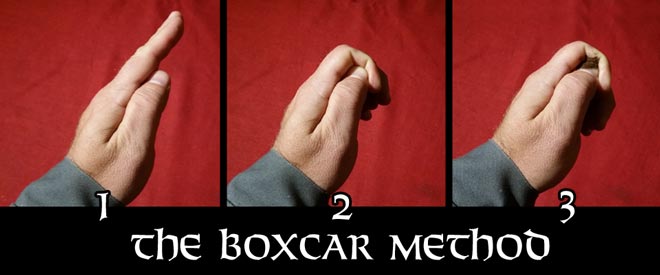
If you put one nostril's worth on your thumbnail, you'll have to do this twice obviously in order service both nostrils. If you put two nostril's worth on your thumbnail, you'll need to pull half of it up one nostril and the rest up the second nostril. Getting an even dose in each nostril from one pile of snuff in your boxcar takes a little practice. But, once you have it down, using the boxcar to hit both nostrils is very quick and a fairly inconspicuous way to take your snuff.
For some mysterious reason, you can put a lot more snuff comfortably up your nose using the boxcar method than you can with a pinch, spoon, or off the back of your hand. For whatever reason, it just works well for taking large amounts of snuff comfortably.
There is a clever device that can be used to conveniently both carry and take your snuff. Snuff bullets consist of a small container of snuff, at the top of which is a valve capable of measuring out a small does of snuff. The bullet is then placed in the nostril, and a light sniff delivers the consistant dose of snuff into your nose. Snuff bullets are available in all kinds of interesting materials, and they vary in both quality and price.
One of the drawbacks of most snuff bullets is the relatively small dose they deliver. For many snuff-takers, they deliver far too little snuff per dose. With plastic snuff bottles, the chamber within the value that gathers the dose of snuff can be carefully enlarged, and in this way some snuff-takers customize their bullet to deliver more snuff.
For the most part, snuff bullets work best with fine and medium-fine snuff grinds. Course grinds do not usually work very well in snuff bullets, because the course grains of snuff don't properly fill the valve chamber that is supposed to fill with the dose of snuff. Despite these drawbacks and limitations, if you find the right snuff bullet and a snuff that works well with it, carrying a snuff bullet in your pocket is enormously convenient.
A Few Other Methods
There are other ways to get the snuff into your nose. Snuff-board contraptions that snap the snuff into the air as you take your sniff. It is possible to draw snuff into your nose through a straw, though this is usually not a very comfortable way of doing it. You can even use a flexible tube or bendy-straw, with one end in your nose and one end in your mouth, to blow the snuff from the tube into your nose. If you look around on the internet, you'll find more information on these methods and others. For this page, we chose to describe in detail the common ways most snuff-takers use to enjoy snuff.

If you have any questions about the methods described above, please feel free to contact me. But, I'd also encourage you to contact other snuff-takers and ask them what they do and how they do it. Learning form multiple perspectives, and finding out what works for you through your own trial and error is definitely the best way to go.
Please feel free to click the button
above or to contact me
directly at markstinson@onmail.com. And
don't forget to visit the Modern Snuff Blog
or Facebook
Group.
Modern Snuff © 2015, 2016, 2023 by Mark Stinson

